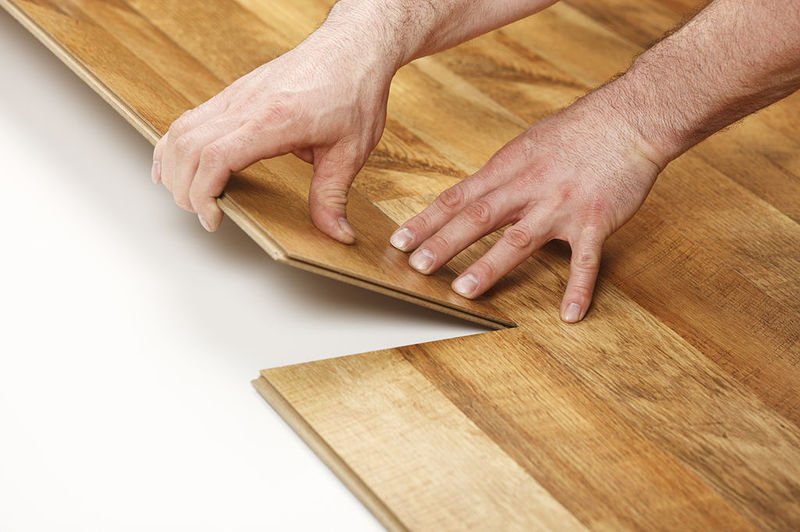For those homeowners wondering how to replace water damaged laminate flooring board, there are 4 steps you can easily follow. It might come off as a surprise for most since laminate flooring is known for having a highly durable built-in water resistance. While that is the case, it could still fall victim to damage from puddles, spills, and other sources of moisture.
If you see clear evidence of water damage on your laminate floor, it is best to take action immediately! Here is a guide to help you replace your water damaged laminate flooring!

Steps On Replacing A Laminate Flooring Board
Laminate flooring is designed to withstand occasional spills. Though, what happens when that tiny spill turns to a deluge?
When laminate is exposed to water and moisture, the planks will bend, buckle, or give underweight. A true sign of disaster waiting to happen. Luckily, there are steps you can follow to replace those damaged boards!
Step #1. Check and stop leaks
First things first, you must focus on the source. You would not be able to fix the damage unless you stop the source, which in this case, is the leak. It comes first as it will prevent your floor from getting even wetter.
Check if there are any leaks in the laminate flooring. Then, see if any appliances that use water are near to the damaged area, such as washing machines, dishwashers, and more. You can also check the toilet and pipes underneath the flooring.
Once you locate the source and stop it, you can revert your attention to the damaged boards. It is best to inspect the extent of the problem first before jumping to the job of replacing it.
Step #2. Prepare tools
You will need to prepare all the necessary tools for the removal and replacement process. Gather up safety glasses, measuring tape, pliers, hammers, flooring adhesive, and all the other vital tools you will need.
Aside from the tools, you will need to prepare new laminate planks to replace the old and damaged ones. For consistency and aesthetic purposes, look for laminate planks that match yours.
Step #3. Remove the damaged planks
You will then need to remove the damaged boards and get to work on replacing them with new ones. Laminate floorboards warped from water damage may be removed using bare hands. The others, however, will require more attention and effort to remove.
You may use any thin tool, such as a knife, to slip it under the board and lift it. Even with small damaged areas, you will still need to remove the entire board. It is to prevent it from worsening by leaving it and also to expose the floor beneath it.
Step #4. Replace the damaged planks
This serves as the most challenging part of the whole process. Before installing the new boards, ensure that the bare floor is cleaned. Also, check the replacement boards and see if they would fit perfectly on the new space on the floor.
Do note that there is a difference in replacing damaged boards in the middle of the room and those close to the wall.
Using adhesive, start putting the replacement laminate boards in place. Leave a heavy object on top of the new board for a couple of hours or up until the adhesive dries up.
When in doubt, call up a professional. Homeowners’ insurance generally covers damages and destruction of the house’s interior and exterior. You can check if water damaged flooring replacement is part of the insurance coverage.
For any related insurance claim, it is best to call up a lawyer.
What Are Signs Of Laminate Floor Water Damage?
Sometimes, even despite your best efforts, water damage could still happen. Whether it be an unnoticed spill, a leaky pipe, or even something more catastrophic such as flooding, your laminate floor can be left vulnerable after a long period of exposure to moisture.
A few warning signs you can look out for water damage are:
- Splitting
- Cracking
- Buckling
- Discolouration
- Warping
- Visible mold or moldy odor
If you notice any of these signs, better inspect your floors right away for water damage.
What Are The Sources Of Water Damage In Laminate Floors?
Typically the damage often originated from the kitchen where sinks, ice maker lines, and dishwashers are located. Areas near appliances that use water, such as washing machines, are also vulnerable to water damage.
How To Prevent Your Laminate Flooring From Getting Water Damaged?
While there are aspects to water damage you can’t exactly control (like flooding), you can still do things to help reduce the risks and chances of water damage to your laminate floors. The vast majority of water damage causes are preventable.
There are simple things you can do — from wiping your spills to keeping an extra eye out for any leaks around your sinks, toilets, appliances, and more. These may seem like small, random tasks, but it does help prevent water damage from coming to your floors.
Prevention is always the best method when it comes to evading water damage. Staying vigilant in your home and dealing with issues and problems as soon as they pop up can help reduce the chances of any long-term detriment to your floors.
Conclusion
Replacing water damaged floors is not exactly a walk in the park. With the right guide, though, it will undoubtedly be easier. For those pondering on how to replace water damaged laminate flooring board, you can follow a few steps!
